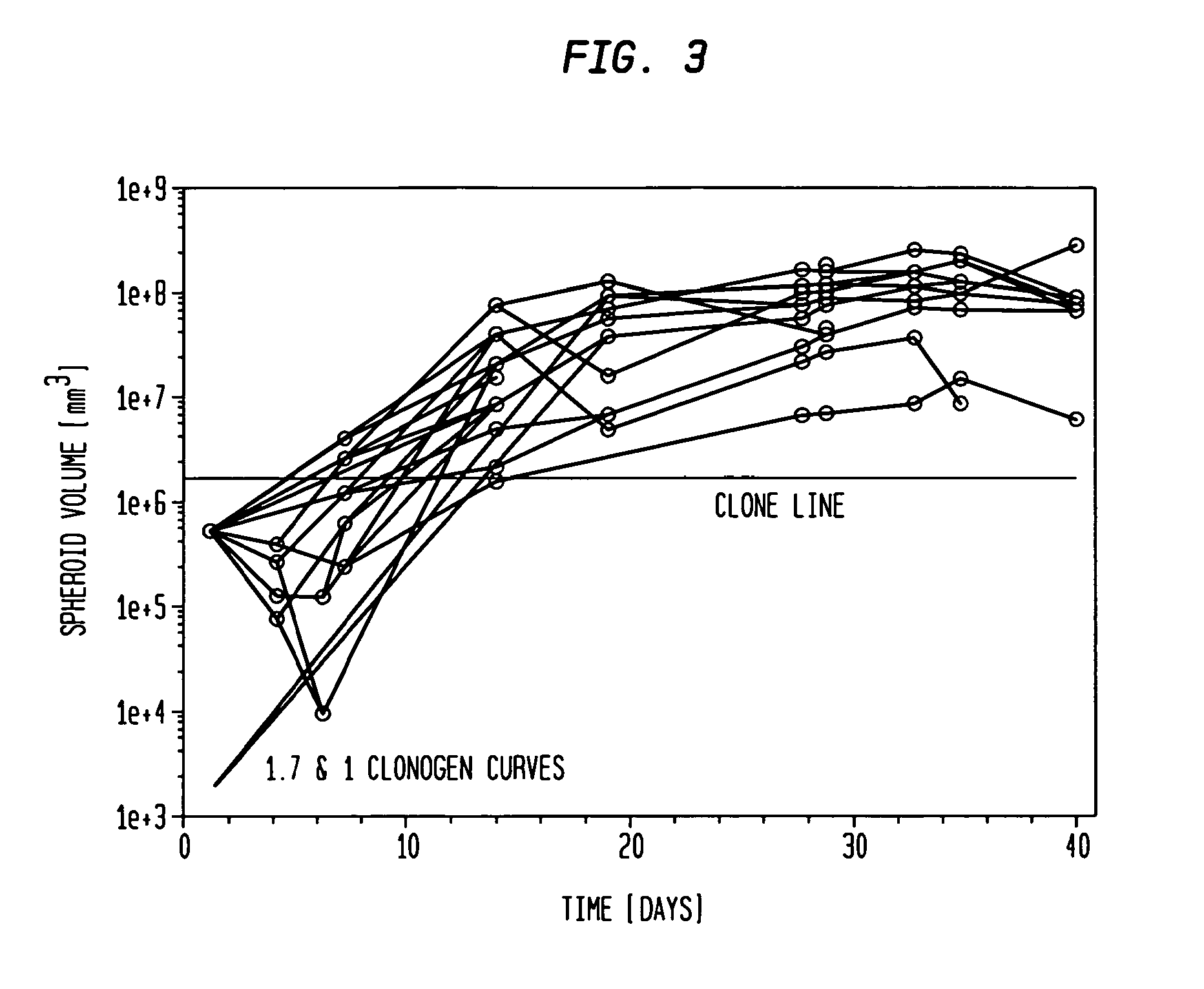Methods of assaying sensitivity of cancer stem cells to therapeutic modalities
a cancer stem cell and sensitivity technology, applied in the field of single cancer stem cell proliferative ability measurement, can solve the problems of low plating efficiency, inconvenient identification of stem cells, and inability to predict individual patient outcomes, so as to achieve the effect of csc growth and maintenance of stem cell properties
- Summary
- Abstract
- Description
- Claims
- Application Information
AI Technical Summary
Benefits of technology
Problems solved by technology
Method used
Image
Examples
example 1
Research Methods
[0048]Types of spheroids: Two types of spheroids are used in this study: (1) Pure fibroblast spheroids, in which all the cells are fibroblasts; (2) Hybrid spheroids, in which two cell types are mixed (primary breast cancers, mixed with fibroblasts), one type being the test cells whose growth and viability are being measured (0.5% to 40% of the initial spheroid cells), while the other type consists of nonclonogenic fibroblast feeder cells (99.5% to 60% of the initial spheroid cells; rendered such by culture condition).
[0049]Cell lines used: Two cell types can be used: human diploid fibroblasts (either AG1522 early passage male or RMF-EG hTERT immortalized GFP labeled female) retrieved from liquid nitrogen storage shortly before use, and cells obtained directly from breast cancer surgical samples.
[0050]Tumors to be studied: Tumors tissues are obtained from patients to be analyzed. For the examples provided below, Dr. Schwartzman, Chief of General Surgery in the Surgery...
example 2
[0070]The hybrid spheroid (hs) assay: To alleviate the problems in the prior art methods, an in vivo-like system, the hs assay suitable for testing primary tumor cells has been developed [Djordjevic B. et al., Acta Oncologica, 2006, 45, 412-420; Djordjevic B. et al., Radiat. Res. 53rd Annual Meeting Program Book p 99 (PS179), Nov. 6-9, 2006, Philadelphia, Pa.; and Djordjevic B. et al., Int J Radiat Oncol Biol Phys 1992; 24(3): 511-518; Lange C. S. et al., Int J Radiat Oncol Biol Phys 1992, 24(3): 511-518; Djordjevic, B. et al., Cancer Invest 1991, 9(5): 505-512; Djordjevic B. et al., Cancer Invest. 1993, 11(3): 291-298; Djordjevic B. et al., Acta Oncologica 1998, 37: 735-739; Djordjevic B. et al., Radiat Res 1998, 150:275-282; Djordjevic B. et al., Indian J Exper Biol 2004, 42: 443-447] (see below). The system exhibits a much higher PE, ˜0.5-2% [Djordjevic B. et al., Acta Oncologica, 2006, 45, 412-420], with almost all samples producing sufficient colonies for assay [Djordjevic B. e...
PUM
| Property | Measurement | Unit |
|---|---|---|
| diameter | aaaaa | aaaaa |
| time | aaaaa | aaaaa |
| doubling time | aaaaa | aaaaa |
Abstract
Description
Claims
Application Information
 Login to View More
Login to View More - R&D
- Intellectual Property
- Life Sciences
- Materials
- Tech Scout
- Unparalleled Data Quality
- Higher Quality Content
- 60% Fewer Hallucinations
Browse by: Latest US Patents, China's latest patents, Technical Efficacy Thesaurus, Application Domain, Technology Topic, Popular Technical Reports.
© 2025 PatSnap. All rights reserved.Legal|Privacy policy|Modern Slavery Act Transparency Statement|Sitemap|About US| Contact US: help@patsnap.com



